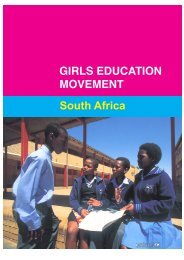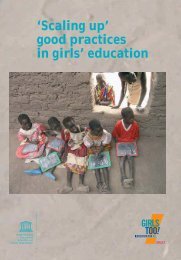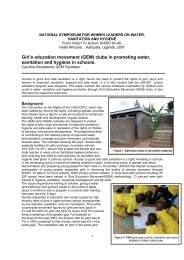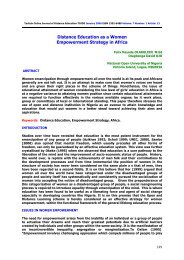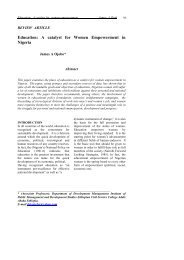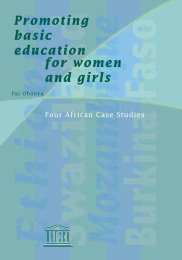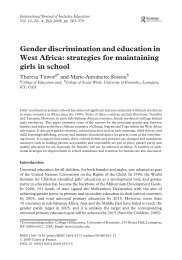Making Schools Safe for Girls - library.unesco-ii...
Making Schools Safe for Girls - library.unesco-ii...
Making Schools Safe for Girls - library.unesco-ii...
- No tags were found...
You also want an ePaper? Increase the reach of your titles
YUMPU automatically turns print PDFs into web optimized ePapers that Google loves.
Research MethodsTwo large provincial towns and their surroundings in the Mono/ Couf<strong>for</strong>egion of southwestern Benin were identified <strong>for</strong> this case study, undertakenin partnership with the Center <strong>for</strong> Gender Equity at the Academy <strong>for</strong> EducationalDevelopment and World Learning’s Community Action <strong>for</strong> <strong>Girls</strong>’Education (CAGE) project. The research was carried out in January andFebruary of 2004, beginning with four half-day community workshops, eachinvolving 15-20 participants. Two of the workshops included upper primaryand lower secondary students, and two included parents with daughtersenrolled in school. The workshops used Participatory Learning and Action(PLA) techniques to:• Identify the problems at school that girls find most troubling.• Articulate female students’ perspectives on gender-based violence, discoveringwho perpetrates it, its frequency, and how it typically occurs.• Explore the factors that contribute to abusive behavior in the school environmentand consider possible strategies to address this problem.After the workshops, a total of 70 girls, 30 from primary school and 40 fromsecondary school, were interviewed individually. Ages ranged from 11 to 19due to high rates of over-age enrollment and frequent repetition of grades inBenin. Interview questions with girls covered: (a) their home background,including family members they live with; (b) their thoughts on the problemsthey have at school; (c) the types of GBV they had witnessed or experiencedat school; and (d) how GBV at school affects girls as well as what normally isand should be done about it.This case study, while not representative of the country as a whole, nonethelessprovides a window into what happens in Beninese schools, suggestingthat gender-based violence and teacher-student sex are more common thanmost schools care to admit.7



